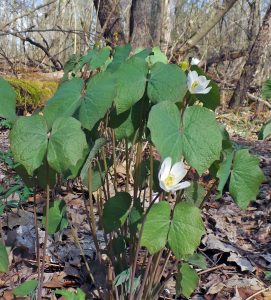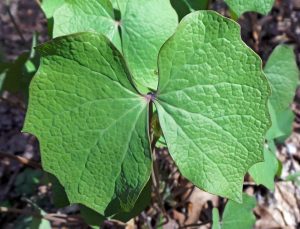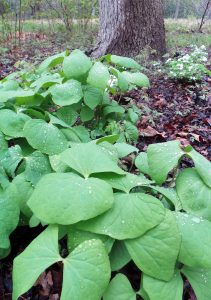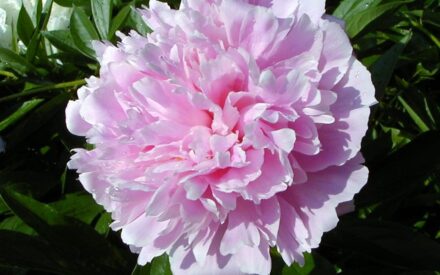
Jeffersonia is a genus in the barberry family (Berberidaceae) with a single species in North America (and one other in Japan) named after Thomas Jefferson, who grew this plant in his gardens at Monticello. Jeffersonia diphylla is native to moist deciduous forests of eastern North America from Minnesota and Iowa east to Ontario, Canada and New York and south to Alabama and Georgia. It is relatively uncommon in its range and is endangered in some areas because of both habitat destruction and invasive species. It is hardy in zones 4-9.

This ephemeral herbaceous perennial emerges early in the spring before the trees leaf out. Both leaves and flowers are produced at the same time from the rhizome on long, smooth, purplish stems.

Each large, blue-green leaf has two deeply divided symmetrical lobes, somewhat like a butterfly with its wings spread open, which gives rise to its common name of twinleaf. The leaves may be coarsely toothed or wavy around the edges. The foliage is only about 6-8 inches tall when the flowers open before or as the leaves expand. The clumps of plants later grow up to 18 inches tall, forming a mound of foliage through early to mid- summer before senescing and disappearing for the remainder of the year.
The showy, one inch wide white flowers look similar to bloodroot (Sanguinaria canadensis, although that plant is in the poppy family). Each solitary, cup-shaped flower has four sepals, eight spatulate petals and eight erect yellowish stamens surrounding the green ovary. There may be multiple flowering stems in each clump. The flowers are very short-lived, with the petals quickly dropping.

The fruits that follow the flowers are leathery, pear-shaped capsules which turn from green to yellow-green as they mature. A suture near the top opens like a hinged lid when the capsule is ripe to release the oblong, shiny brown seeds. The seeds are dispersed by ants.


Jeffersonia grows best in rich, moist but well-drained soil with plenty of humus. In their native habitat, they occur only under deciduous trees where they start out in part sun but are in shade by summer. This plant has few pests and is well suited to woodland or shade gardens. It can be used as a ground cover for shady areas but will decline in mid to late summer. Place it near paths where its flowers can be seen up close. Combine it with native ferns, other spring ephemerals such as mayapple (Podophyllum peltatum), rue anemone (Thalictrum thalictroides), and Dutchman’s breeches (Dicentra cucullaria), or other non-aggressive herbaceous woodland plants.
This plant is easily propagated from fresh seed or by careful division of large clumps in late summer or fall. Dormant bare root plants can be transplanted in early spring. Young plants are easily outcompeted by other plants and take many years to begin blooming.
– Susan Mahr, University of Wisconsin – Madison
Ask Your Gardening Question
If you’re unable to find the information you need, please submit your gardening question here:





 Alternatives to Lawn: Groundcovers
Alternatives to Lawn: Groundcovers Marigolds
Marigolds Peony
Peony Iris Severe Mosaic
Iris Severe Mosaic


